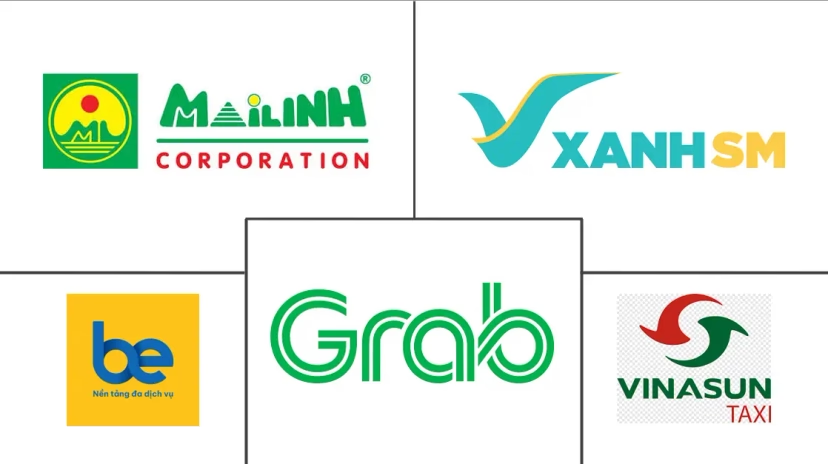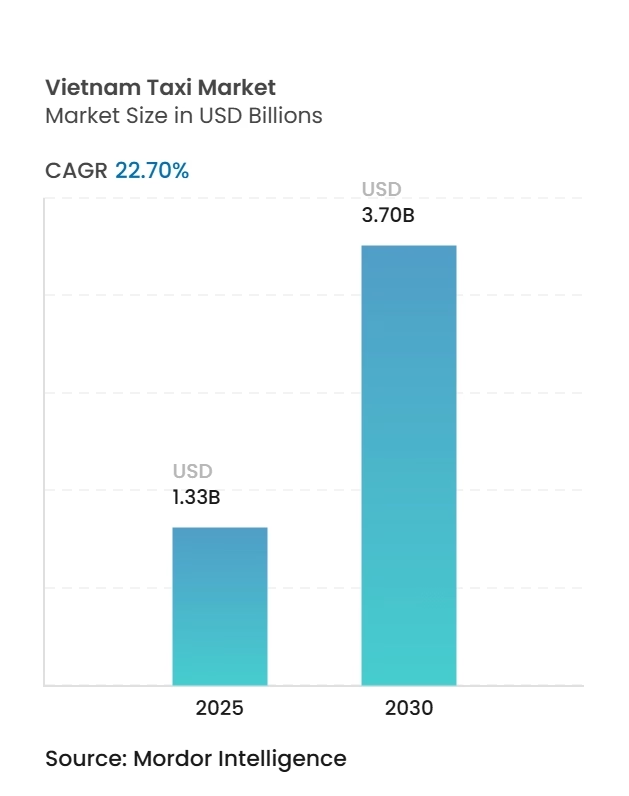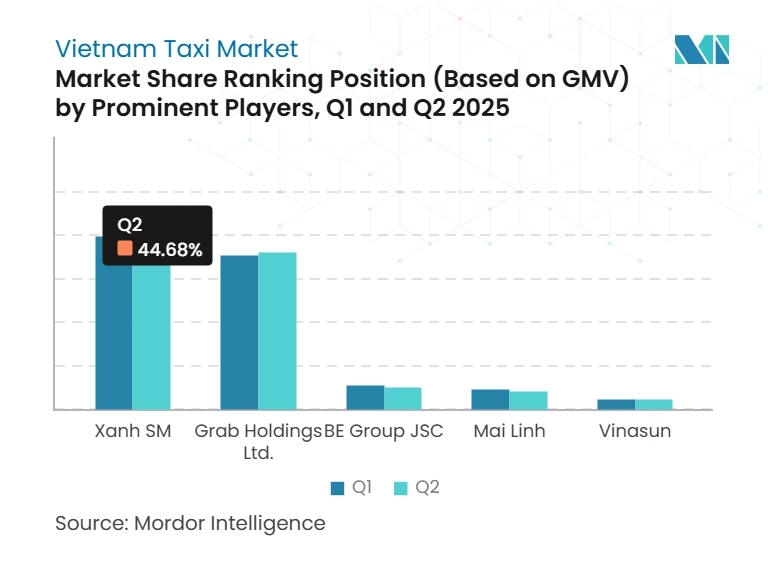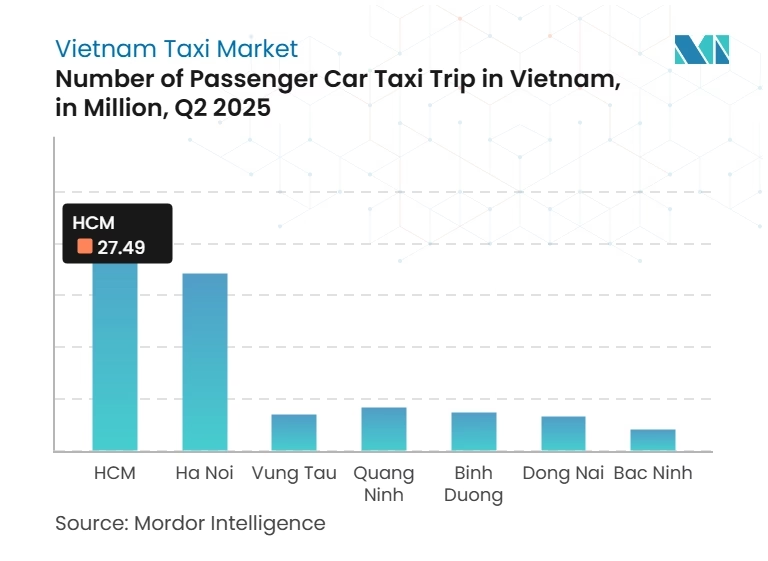Vietnam Taxi Market Size and Share
Market Overview
| Study Period | 2020 - 2030 |
|---|---|
| Base Year For Estimation | 2024 |
| Forecast Data Period | 2025 - 2030 |
| Market Size (2025) | USD 1.33 Billion |
| Market Size (2030) | USD 3.70 Billion |
| Growth Rate (2025 - 2030) | 22.70 % CAGR |
| Market Concentration | High |
Major Players *Disclaimer: Major Players sorted in no particular order Image © Mordor Intelligence. Reuse requires attribution under CC BY 4.0. |

Vietnam Taxi Market Analysis by Mordor Intelligence
The Vietnam Taxi Market size is estimated at USD 1.33 billion in 2025, and is expected to reach USD 3.70 billion by 2030, at a CAGR of 22.70% during the forecast period (2025-2030).
Vietnam is long and narrow, extending over 1,650 km north to south while varying in width between 50 km and 500 km. Most of the country's population resides along the coasts; Vietnam has a 3,260 km coastline on the South China Sea and the Gulf of Tonkin, as well as over 3,000 islands and extensive internal waterways. Accordingly, an exceptionally high share of freight is transported by water.
Taxis have become a primary mode of transportation in Vietnam. Following the 2016 implementation of Decision No. 24/QD-BGTVT by the Ministry of Transport, which aimed to reduce costs for Vietnamese taxis and mobile app booking services, demand for taxis in the country has surged. As more users turn to taxi services, the sector's revenue is poised for significant growth in the coming years. In addition, the rising popularity of taxis and aggressive marketing strategies focused on pricing and innovation have also intensified competition. For instance,
- Vingroup’s Xanh SM has rolled out its S2S (Secure to Safe) safety monitoring system across its electric taxi fleet. This move underscores a commitment to bolstering passenger safety, especially for vulnerable groups like children, women, and the elderly, and aligns with global safety benchmarks. The initiative also highlights Vingroup’s dedication to integrating advanced technology into its services to enhance user experience and safety.
Additionally, traditional taxi companies now find themselves competing with a wave of new global players entering the market. The integration of advanced technology, such as GPS tracking and cashless payment systems, has further enhanced the appeal of taxi services, making them more convenient and accessible for consumers. This technological advancement is expected to play a crucial role in shaping the competitive landscape of the sector in the forecast period.
- In Q1 2025, the State Bank of Vietnam reported a notable increase in cashless transactions among Vietnamese consumers. During this period, the country recorded an impressive 5.5 billion cashless transactions. Of these, 4.5 billion were digital transactions, amounting to a total value of approximately USD 1.6 trillion.
In Vietnam, traditional taxi services are a staple, offering a seamless way to navigate cities and tourist hotspots. Some of the major players dominate the landscape, ensuring reliable, metered transportation. This is attributed to their professional drivers and well-maintained vehicles, which contribute to their reputation for safety and reliability. Whether hailed on the street, found at designated stands, or booked via hotel services, these taxis have earned the trust of both locals and tourists alike. Additionally, their widespread availability makes them a convenient option for travelers seeking hassle-free transportation.
Vietnam Taxi Market Trends and Insights
Economic Rebound And Surge In Tourism Across The Country
In Q2 2025, Vietnam's economy showed significant growth, driven by a recovery in domestic activities and a resurgence in international tourism. The country recorded approximately 7.9 million foreign tourist arrivals, a notable 24% rise compared to the same quarter of the previous year. This increase supported local businesses and contributed to the expansion of the passenger car taxi market. The growing demand for transportation services from the influx of visitors benefited operators and positively influenced Vietnam's economic landscape.
In Q1 2025, the tourism industry experienced a significant rise in travelers from Poland and Switzerland, with arrivals increasing by 52.9% and 14.1%, respectively, compared to the same period last year. This growth is primarily attributed to the government's strategic initiative outlined in Resolution 11/NQ-CP, which aims to enhance the travel experience for tourists from Poland, the Czech Republic, and Switzerland.
The initiative introduces short-term visa exemptions, simplifying travel procedures and encouraging tourists to explore. As a result, this measure is expected to drive a substantial increase in visitors from these nations, contributing to the local culture and economy throughout the year. This policy reflects the government's commitment to promoting international tourism and creating a welcoming environment for travelers seeking new destinations.
Travelers are opting for organized taxi services for sightseeing, aiming for a hassle-free way to visit must-see destinations. This rise in tourist numbers and transportation demand highlights the crucial role of reliable transportation in enhancing the travel experience in these key Vietnamese cities.
Vietnam's growing prominence as a destination for conferences, exhibitions, and business meetings has significantly increased the demand for reliable taxi services. The rise in business travel and international events has driven local taxi operators to enhance their services to meet this demand.
To address the growing needs, taxi companies are expanding their fleets to accommodate the increasing number of passengers. These expansions include investments in modern vehicles equipped with advanced technology to provide comfort, safety, and convenience for international travelers.
Additionally, operators are focusing on improving service quality by training drivers in customer service and adopting practices that cater to a diverse clientele. These efforts not only fulfill the immediate requirements of tourists but also strengthen the competitive positioning of local businesses, ensuring a positive and memorable experience for visitors to Vietnam.
As a result, during the second quarter of 2025, Vietnam's passenger car taxi industry witnessed notable growth, driven primarily by a surge in tourism. The increased influx of travelers boosted the demand for transportation services, revitalizing the market and expanding the taxi segment.

Ho Chi Minh City leads the market
In Vietnam, urbanization, technological advancements, infrastructure upgrades, rising disposable incomes, and a heightened focus on safety and security are fueling the demand for passenger car taxis. With these trends continuing to evolve, Vietnam's passenger car taxi market is set for further growth. Additionally, the surge in popularity of ride-hailing platforms like Xanh SM and Grab has bolstered this expansion, providing consumers with seamless access to taxi services via mobile apps.
Ho Chi Minh City, Vietnam's largest economic center and most populous city, stands as a pivotal transportation hub. This status fuels a robust demand for both traditional taxis and ride-hailing services. With a dynamic population, a thriving tourism sector, and bustling commercial areas, the city witnesses substantial daily taxi usage, keeping its streets lively around the clock.
Tourists are flocking to the region, and residents are increasingly opting for the convenience of private transport, fueling robust growth in the taxi and ride-hailing industry. Moreover, with the rising penetration of the internet and smartphone usage in Vietnam, accessing ride-hailing platforms has become easier, further propelling the adoption of these services. The number of tourists arrival in the province is anticipated to witness steady growth throughout the forecast period, bolstering the market's sustained growth.
- For the first six months of the year 2025, the number of international tourist arrivals in Ho Chi Minh city is anticipated to be around 48% higher compared to the same period of last year. In the first half of the year 2025, tourism revenue in the city witnessed a growth of 16.9%, compared to the same period of last year.
As ride-hailing and taxi usage surges, the market is set for significant growth. A key driver of this uptick has been the influx of international tourists to Vietnam over recent years. Notably, Ho Chi Minh City, a favored destination for many tourists, has been at the forefront of this rapid industry expansion.
Ho Chi Minh Province grapples with a swiftly urbanizing population, limited public transport, and escalating traffic congestion. These challenges have spurred a heightened demand for private transportation. The lack of efficient public transit options has made private modes of transport, such as taxis and ride-hailing services, a preferred choice for many.
The government is pushing for electric vehicle adoption to foster a sustainable transportation ecosystem. These efforts not only combat climate change but also nurture the taxi and ride-hailing services in cities such as Ho Chi Minh City. As a result, the sector is poised to see increased investments, spur innovation, and bolster the growth of eco-friendly transportation solutions, reinforcing the market's upward trajectory.

Competitive Landscape

In Vietnam's taxi market, traditional operators and tech-savvy ride-hailing platforms are locked in a battle for supremacy. Over the years, these companies have cultivated a reputation for reliability, primarily catering to customers who favor traditional booking methods and fixed pricing. Yet, they grapple with challenges: surging operational costs, from fuel to maintenance, and a rising consumer tilt towards the convenience of app-based services. In a bid to seize a larger slice of the market, players are broadening their horizons. For instance,
- In June 2025, Xanh SM and V-Green, integral to Vingroup's vision for a sustainable green ecosystem, collaborated with Vietnam Securities Investment JSC (CK Vietnam) to promote electric transportation in Nghe An province, Vietnam. This partnership seeks to redefine how residents and visitors interact with electric vehicles by integrating CK Vietnam's services into the user-friendly Green SM app. This integration simplifies vehicle booking, streamlines payment processes, and improves operational efficiency, supporting an eco-friendlier transportation system in the region.
- In April 2025, Xanh SM introduced the "Bike upgrade to Car" initiative, enabling its electric motorbike drivers in Hanoi and Ho Chi Minh City to transition into electric taxi drivers. Those holding a valid car license can access complimentary training, financial incentives, and career advancement assistance. This initiative not only promotes sustainable transportation but also enhances the earning potential for drivers making the switch from bikes to cars.
- In March 2025, Haima Motor, a Chinese automaker, unveiled its 7X-E battery electric vehicle (BEV) model in Vietnam's taxi market, as announced on its WeChat account. Partnering with Carvivu Vietnam Joint Stock Company ("Carvivu"), this move marks a significant step in Haima Motor's push into Association of Southeast Asian Nations' (ASEAN's) green transportation arena.
Vietnam Taxi Industry Leaders

*Disclaimer: Major Players sorted in no particular order
Recent Industry Developments
- April 2025: Xanh SM started implementing the S2S (Secure to Safe) safety monitoring system across its nationwide electric taxi fleet. This initiative positions Xanh SM as the first taxi company in Vietnam to adopt comprehensive safety measures for passengers, particularly children, women, and the elderly, aligning with standards of developed nations. The S2S system includes interior and exterior surveillance cameras, emergency buttons for drivers and passengers, smart sensors, and AI-powered software for real-time behavior analysis and anomaly detection. In case of incidents or threats, the system alerts the Operations Center for immediate support from nearby drivers or authorities.
- April 2025: In April 2025, G7 Taxi Management Joint Stock Company signed a memorandum of understanding with GSM Green and Smart Mobility Joint Stock Company to procure 899 VinFast electric vehicles. As per the agreement, G7 Taxi will acquire 899 white VinFast VF 5 cars to implement green taxi services in major cities by the end of 2025.
- April 2025: Xanh SM introduced its interprovincial carpooling service, Xanh SM Interprovincial, designed to serve customers with similar travel itineraries. This initiative represents the company's initial step in executing its strategy to expand the long-distance electric taxi network, aiming to establish a green, transparent, and convenient nationwide transportation system. The Green SM Interprovincial Service leverages the quality standards of the Green SM Premium electric taxi service and exclusively utilizes VinFast VF e34 electric vehicles.
Table of Contents for Vietnam Taxi Industry Report
1. INTRODUCTION
- 1.1Study Assumptions & Market Definition
- 1.2Scope of the Study
2. RESEARCH METHODOLOGY
- 2.1Research Framework
- 2.2Secondary Research
- 2.3Primary Research
- 2.4Data Triangulation & Insight Generation
3. EXECUTIVE SUMMARY
- 3.1Executive Summary and Key Findings
- 3.2Taxi market share (in %), by company, Vietnam, Change in market ranking/position, from Q1 2024 to Q2 2025 (Based on Market Share)
- 3.3Market Ranking in terms of GMV/Day (Q2 2025)
- 3.4Market Ranking in terms of Number of Trips (Q2 2025)
- 3.5Market Ranking in terms of Network Coverage (Q2 2025)
- 3.6Market Ranking in terms of Service Quality (Q2 2025)
- 3.7Role of Taxi and Ride-Hailing Companies in Vietnam
- 3.8Assessing the Market Potential By Introducing Electric Vehicles to the Taxi Market in Vietnam and Other Countries
- 3.9Market Aspects that Can Attract Investment
- 3.10Key Success Factor for Vietnam Taxi and Ride-hailing Service
4. MARKET DYNAMICS
- 4.1Market Drivers
- 4.1.1Economic Rebound And Surge in Tourism Across the Country
- 4.1.2Rapid Urbanization and Rising Incomes
- 4.1.3Smartphone-Based Ride-Hailing Adoption
- 4.2Market Restraints
- 4.2.1Regulatory Challenges May Impact the Market Growth
- 4.3Industry Attractiveness - Porter's Five Forces Analysis
- 4.3.1Threat of New Entrants
- 4.3.2Bargaining Power of Buyers/Consumers
- 4.3.3Bargaining Power of Suppliers
- 4.3.4Threat of Substitute Products/Services
- 4.3.5Intensity of Competitive Rivalry
5. MARKET SEGMENTATION
- 5.1Propulsion Type
- 5.1.1Internal Combustion Engine (ICE)
- 5.1.2Electric and Hybrid
- 5.2Province
- 5.2.1Ho Chi Minh City
- 5.2.2Ha Noi
- 5.2.3Quang Ninh
- 5.2.4Binh Duong
- 5.2.5Vung Tau
- 5.2.6Dong Nai
- 5.2.7Bac Ninh
- 5.2.8Da Nang
- 5.2.9Thanh Hoa
- 5.2.10Thai Nguyen
- 5.2.11Vinh Phuc
- 5.2.12Can Tho
- 5.2.13Hung Yen
- 5.2.14Phu Tho
- 5.2.15Ninh Binh
- 5.2.16Hue
- 5.2.17Others (Hai Phong, Nghe An, Etc.)
6. COMPETITIVE LANDSCAPE
- 6.1Vendor Market Share
- 6.2Benchmarking of Major Players
- 6.3Company Profiles
- 6.3.1Xanh SM (GSM)
- 6.3.2Grabtaxi Holdings Inc.
- 6.3.3TADA
- 6.3.4Be Group JSC
- 6.3.5Mai Linh Corporation
- 6.3.6inDrive
- 6.3.7Vinasun Corporation
- *List Not Exhaustive
7. MARKET OPPORTUNITIES AND FUTURE TRENDS
Vietnam Taxi Market Report Scope
A taxi service includes ride-hailing services and offline traditional taxi services. Ride-hailing service refers to an online service, that via website and mobile applications, match passengers with drivers of vehicles for hire. Whereas the offline traditional taxi services can be held by the passengers from the street and does not require any smartphone-based applications of websites to book the ride. The scope of the study includes passenger cars taxi services and ride-hailing services, whereas two-wheeler taxi services and ride-hailing services have been excluded from the scope
Vietnam Taxi Market is segmented by Propulsion Type and by Province. By Service Type, the market is segmented into Traditional Taxi and Ride-Hailing. By Propulsion Type, the market is segmented into Internal Combustion Engine (ICE) and Electric & Hybrid. By Province, the market is segmented into Ho Chi Minh City, Hà Nội, Quảng Ninh, Binh Duong, Vũng Tàu, Dong Nai, Bắc Ninh, Đà Nẵng, Thanh Hóa, Thái Nguyên, Vĩnh Phúc, Cần Thơ, Hưng Yên, Phú Thọ, Ninh Bình, Huế, and Others. For each segment, market sizing and forecast have been done on the basis of value (USD) and volume (Number of Trips).
| Propulsion Type | Internal Combustion Engine (ICE) |
| Electric and Hybrid | |
| Province | Ho Chi Minh City |
| Ha Noi | |
| Quang Ninh | |
| Binh Duong | |
| Vung Tau | |
| Dong Nai | |
| Bac Ninh | |
| Da Nang | |
| Thanh Hoa | |
| Thai Nguyen | |
| Vinh Phuc | |
| Can Tho | |
| Hung Yen | |
| Phu Tho | |
| Ninh Binh | |
| Hue | |
| Others (Hai Phong, Nghe An, Etc.) |
